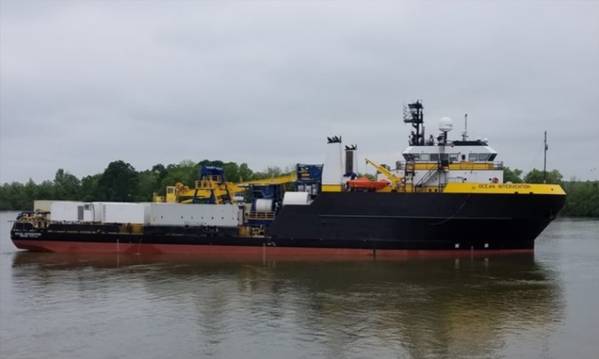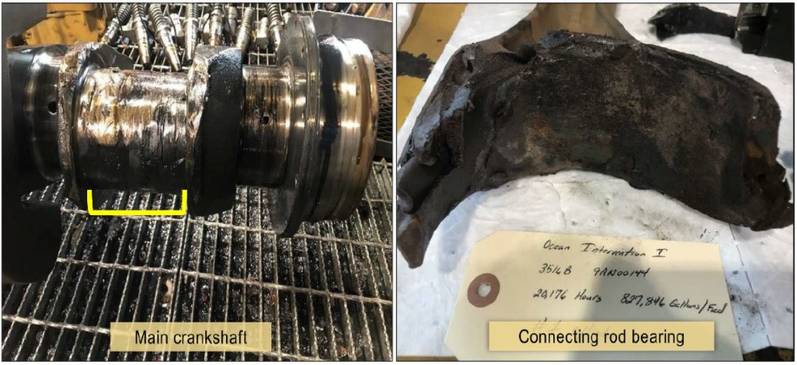
Catastrophic engine damage led to the fire aboard the U.S. -flagged offshore supply vessel Ocean Intervention near Honolulu, the National Transportation Safety Board (NTSB) said.
No pollution or injuries to the 16 crewmembers were reported in connection with the mechanical failure, which resulted in a fire in the engine room on December 19, 2020. The crew isolated the fire before it could spread throughout the vessel.
The Ocean Intervention, a 243-foot-long, steel-hulled vessel, was built in 1998 and operated by Oceaneering International, Inc. The 2,262-gross-ton multi-service vessel was designed to carry goods, supplies, personnel, and equipment in support of offshore energy operations. It was outfitted with specialized equipment, such as remotely operated vehicles for underwater surveys, inspections, maintenance, and repair of apparatus such as pipelines, oil wells, and other subsea structures.
While at anchorage, the Ocean Intervention crew had been troubleshooting speed variation issues related to the number 1 and number 3 Caterpillar 3516B 16-cylinder diesel generator engines, which involved replacement and calibration of several electrical components and multiple engine restarts. When later carrying the vessel’s electrical load, the number 3 diesel generator suffered catastrophic mechanical failure. This resulted in cylinder number 1’s connecting rod being ejected through the engine crankcase while running at rated speed. The ejection of the connecting rod allowed atomized oil to be released from the engine and ignite, starting a fire in the engine room.
The crew’s quick and effective actions to prevent the spread of the fire resulted in the fire extinguishing itself without putting crewmembers at risk. Damage to the Ocean Intervention totaled over $3 million.
The probable cause of the diesel generator engine failure was a cylinder’s connecting rod bearing adhering to the crankshaft, which led to the ejection of the connecting rod and catastrophic damage to the engine, the NTSB determined.
“Engine rooms contain multiple fuel sources as well as mechanical ventilation, making the spaces especially vulnerable to rapidly spreading fires,” the report said. “The crew of the Ocean Intervention effectively contained the spread of a fire by removing fuel and oxygen sources. Vessel crews should familiarize themselves and train frequently on machinery, fuel oil, lube oil and ventilation shutoff systems to quickly act to contain and suppress engine room fires before they can spread to other spaces and/or cause a loss of propulsion and electrical power.”
 The yellow bracket identifies the damaged area of the main crankshaft of the number 3 diesel generator (left), where the number 1 connecting rod bearing failed (right). (Photo: Oceaneering International / NTSB)
The yellow bracket identifies the damaged area of the main crankshaft of the number 3 diesel generator (left), where the number 1 connecting rod bearing failed (right). (Photo: Oceaneering International / NTSB)
Following the teardown of the no. 3 DG, and after reviewing the failure investigation report, the operating company sought the guidance of Caterpillar to proactively effect changes to the model 3516 engines throughout its fleet. To provide increased lubrication to the engine bearings, pre-lube pumps were installed on the engines to provide lubricating oil throughout the engine for a fixed time: after receiving a start signal and before the engine began the starting sequence. According to the technicians, pre-lube systems were offered for the model 3500 engines but were not required. Additionally, the operating company requested that Caterpillar technicians research the feasibility of retrofitting the model 3516 engines with oil mist detectors since the manufacturer did not offer a kit or instructions. These protection devices are designed to activate an alarm when a dangerous mist is detected in the crankcase, possibly preventing an engine explosion. According to the technicians, Caterpillar confirmed that it would be possible to retrofit the engines with oil mist-detection systems.
The Ocean Intervention’s manager for maintenance and repairs stated that the frequency of inspections for main and connecting rod bearings on the model 3516 engines installed aboard the Oceaneering vessels would be reduced from 21,500 hours to between 10,000 and 12,000 hours to allow the bearings to be inspected and replaced early out of an abundance of caution. The connecting rod bearings would be replaced following inspection, as they were not able to be used again after being opened. The main bearings would only be replaced during these inspections if they showed abnormal wear. The technicians stated that Caterpillar had no issue with increased inspections and staying within the operational maintenance manual guidelines.